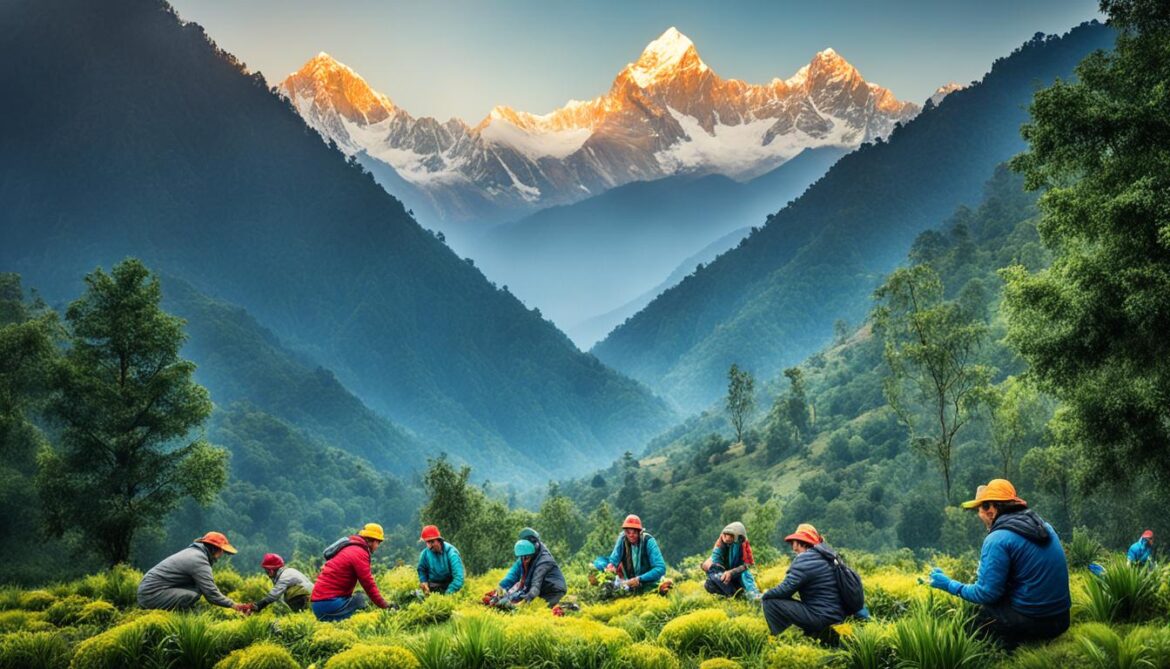Nepal Sacred Natural Sites and Biodiversity
Did you know that sacred natural sites (SNS) are recognized as the oldest form of habitat protection in human history? These sites have played a vital role in biodiversity conservation across different continents and taxonomic groups. While the research on SNS has a geographical and taxonomical bias towards Asia and Africa and plants, the positive effects of SNS on taxonomical diversity, vegetation structure, and cultural uses of biodiversity are undeniable. It’s time to give these sites the official recognition they deserve in conservation frameworks.
Key Takeaways:
- Nepal’s sacred natural sites are considered the oldest form of habitat protection in history.
- These sites have positive effects on taxonomical diversity, vegetation structure, and cultural uses of biodiversity.
- SNS play a crucial role in biodiversity conservation and should be officially recognized in conservation frameworks.
- There is a need for research and conservation efforts to focus on SNS in Asia, Africa, and across various taxonomic groups.
- The spiritual and cultural significance of SNS in Nepal makes their conservation even more critical for the preservation of biodiversity and cultural heritage.
The Importance of Nepal’s Sacred Natural Sites
Sacred natural sites hold great importance in Nepal as they are considered sacred by the local communities and have significant religious and cultural significance. These sites are often associated with Hindu and Buddhist faiths, and it is believed that they serve as the dwelling places of deities.
The religious significance of these natural sites is deeply ingrained in the cultural fabric of Nepal. They are revered and respected by the local communities, who visit these sites to offer prayers, perform rituals, and seek spiritual solace.
Not only do these sacred sites have religious importance, but they also act as hotspots of biodiversity. Nepal is known for its rich biodiversity, and many of these natural sites harbor a wide range of plant and animal species, some of which are unique to the region.
The conservation of sacred natural sites is crucial for maintaining Nepal’s rich biodiversity and preserving its cultural heritage.
The conservation of these sacred natural sites plays a vital role in biodiversity conservation efforts in Nepal. These sites provide sanctuary to numerous plant and animal species, including endemic species that are found nowhere else in the world.
Sacred groves, a type of sacred natural site, are particularly important for biodiversity conservation in Nepal. These groves are traditional community-managed forests that are protected due to their spiritual and cultural value. They act as ecological refuges, providing shelter and resources to a diverse array of species.
The religious and cultural beliefs associated with these sites have contributed to their protection and conservation over centuries. The local communities have a deep sense of responsibility and stewardship towards these sites, and they have implemented traditional conservation practices to ensure their long-term preservation.
Conservation Efforts: Protecting Sacred Natural Sites
Nepal has recognized the importance of these sacred natural sites and has taken steps to conserve and protect them. The government has implemented policies and legislation to safeguard these sites and promote their sustainable management.
Efforts are being made to involve local communities in the conservation of these sites, recognizing their traditional ecological knowledge and stewardship practices. Community-based conservation initiatives have been successful in empowering local communities to take an active role in the preservation of these sacred sites and their surrounding ecosystems.
In addition, partnerships between government agencies, NGOs, and local communities have been formed to implement conservation programs that focus on the sustainable use of natural resources and the protection of sacred natural sites.
Biodiversity Conservation in Nepal: A Shared Responsibility
The importance of Nepal’s sacred natural sites extends beyond religious and cultural significance. These sites are integral to the conservation of the country’s unique biodiversity and play a crucial role in preserving its natural heritage.
Conservation efforts need to recognize and respect the religious and cultural values associated with these sites. By involving local communities, promoting sustainable management practices, and raising awareness about the importance of sacred natural sites, we can ensure their long-term preservation and contribute to biodiversity conservation in Nepal.
Biodiversity Conservation in Nepal
Nepal boasts a remarkable wealth of biodiversity and is home to numerous endemic species. The country has implemented various conservation efforts to safeguard its diverse ecosystems. These initiatives include the establishment of protected areas, national parks, and wildlife reserves. These protected areas serve as havens for a wide range of plant and animal species and are instrumental in preserving Nepal’s unique biodiversity.
However, Nepal faces several challenges in its quest for biodiversity conservation. One of the significant challenges is habitat loss due to deforestation and urbanization, which disrupts the natural ecosystems. Climate change also poses a threat to the delicate balance of Nepal’s biodiversity. The melting of glaciers, changing precipitation patterns, and rising temperatures affect the distribution and survival of various species. Additionally, poaching and the illegal wildlife trade pose a grave danger to many endangered species, further exacerbating the conservation challenges.
To address these challenges, Nepal has adopted community-based conservation initiatives that actively involve local communities in natural resource management. This approach recognizes the importance of the traditional knowledge and practices of indigenous communities in protecting and conserving biodiversity. Through community participation, awareness programs, and sustainable management practices, Nepal strives to mitigate the conservation challenges it faces and promote the long-term sustainability of its natural resources.

Moreover, the creation of protected areas in Nepal serves as a vital tool in conserving endemic species and their habitats. These protected areas provide a safe haven for vulnerable species to thrive and ensure the preservation of their genetic diversity. By designating specific regions as protected areas, Nepal recognises the need to balance human activities with the conservation of its natural heritage.
In conclusion, Nepal’s commitment to biodiversity conservation is evident through its conservation efforts, protected areas, and involvement of local communities. Despite the challenges it faces, Nepal’s dedication to preserving its rich biodiversity and endemic species remains unwavering. By prioritising community participation, sustainable management practices, and protecting vulnerable habitats, Nepal strives to ensure the longevity of its unique ecosystems and the magnificent species that call them home.
Role of Sacred Natural Sites in Biodiversity Conservation
Sacred natural sites play a crucial role in biodiversity conservation. These sites often serve as refugia for endemic and threatened species, providing them with a safe haven from habitat destruction and human disturbance. By preserving old-growth trees and forest patches, sacred natural sites maintain vital habitats for a diverse range of flora and fauna.
However, it is not just the physical attributes of these sites that contribute to biodiversity protection. The spiritual and cultural beliefs associated with sacred natural sites also play a significant role. Communities living near these sites hold them in deep reverence and respect, considering them as sacred places. This intrinsic connection with nature fosters a sense of stewardship, leading to the conservation of the biodiversity within these sites.
Furthermore, the traditional ecological knowledge held by these communities offers invaluable insights into sustainable conservation practices. Passed down through generations, this knowledge encompasses a deep understanding of the local ecosystem and its dynamics. It guides the conservation practices and resource management strategies employed by these communities, ensuring the effective protection of biodiversity.

The integration of traditional practices with modern conservation efforts is key to achieving more effective biodiversity protection. By combining scientific approaches with the wisdom of traditional ecological knowledge, conservation initiatives can leverage the strengths of both approaches.
“The conservation of sacred natural sites is a testament to the intricate interplay between culture, spirituality, and nature. These sites provide not only ecological benefits but also a window into our shared human history and connection with the natural world.” – Dr. Emma Johnson, Biodiversity Conservation Expert
Through collaborative efforts involving local communities, conservation organizations, and policymakers, the conservation benefits of sacred natural sites can be fully realized. By recognizing the vital role of these sites in biodiversity conservation and supporting their protection, we can ensure a sustainable future for both the natural world and the communities that depend on it.
Conservation Benefits of Sacred Natural Sites
To further demonstrate the significant conservation benefits of sacred natural sites, the table below highlights some key advantages:
| Conservation Benefits | Description |
|---|---|
| Biodiversity Protection | Sacred natural sites provide refuge for endemic and threatened species, preserving biodiversity hotspots. |
| Preservation of Old-Growth Trees | Sacred natural sites safeguard ancient trees, promoting forest health and preserving carbon sinks. |
| Traditional Ecological Knowledge | Local communities possess traditional ecological knowledge that informs conservation practices and resource management strategies. |
| Community Engagement | Sacred natural sites engage local communities in conservation efforts, fostering a sense of ownership and responsibility. |
Case Study – Dakshinkali Grove in Nepal
The Dakshinkali Grove, dedicated to the Goddess Kali, is a sacred grove located near Kathmandu, Nepal. This remarkable site holds deep spiritual significance and is considered a symbol of divinity in the region.
The Indigenous communities of Pharping and Chaimale have been the custodians of this sacred grove for generations, practicing indigenous stewardship to preserve its rich biodiversity. Their traditional knowledge and conservation practices have played a crucial role in maintaining the ecological balance of the grove.
The Dakshinkali Grove is home to a diverse array of flora and fauna, including a wide range of medicinal plants. These plants hold immense cultural and medicinal value in local traditions and are protected due to their sacred status within the grove.
However, like many natural sites, Dakshinkali Grove faces challenges from anthropogenic pressures. Road construction and waste pollution pose significant threats to the grove’s pristine features and fragile ecosystem. To ensure the long-term conservation of this sacred site, sustainable management efforts and awareness programs are imperative.
Efforts are underway to raise awareness among local communities and visitors about the importance of preserving the Dakshinkali Grove. Collaborative initiatives involving local stakeholders aim to mitigate the negative impact of anthropogenic activities through sustainable practices.
“The preservation of Dakshinkali Grove is not just a matter of environmental conservation but also serves as a testament to our cultural heritage and spiritual beliefs,” says Sanjay Shrestha, a local community leader involved in the conservation efforts. “It is crucial that we protect and sustainably manage this sacred grove for future generations.”

The image above showcases the serene beauty of Dakshinkali Grove, with its lush greenery and spiritual ambiance. The grove’s tranquil atmosphere and abundant biodiversity make it a haven for spiritual seekers and nature enthusiasts alike.
Indigenous Stewardship and Medicinal Plants Conservation
Indigenous stewardship lies at the heart of the conservation efforts in Dakshinkali Grove. The Indigenous communities’ deep-rooted connection with the grove and their traditional ecological knowledge contribute to the sustainable management of this sacred site.
“Our ancestors passed down their wisdom and teachings about the importance of preserving nature and the sacredness of this grove,”
says Gita Gurung, a member of the Pharping community. “We continue to follow their footsteps in protecting the flora and fauna, including the invaluable medicinal plants that provide us with healing remedies.”
Medicinal plants conservation is a key focus within Dakshinkali Grove. The grove’s diverse range of medicinal plants not only holds traditional medicinal value but also contributes to the broader field of natural medicine. The protection and sustainable use of these plants play a vital role in supporting local healthcare practices and preserving ancient wisdom.
Dakshinkali Grove stands as a testament to the power of indigenous stewardship and the significance of sacred sites in conserving biodiversity and cultural heritage. The efforts to sustainably manage and protect this grove serves as a beacon of hope for future conservation initiatives in Nepal and beyond.
Conservation Challenges for Sacred Natural Sites
Sacred natural sites face a myriad of conservation challenges that threaten their ecological integrity and cultural significance. These challenges are primarily driven by anthropogenic pressures, including deforestation, pollution, and illegal harvesting of plants and wildlife.
Anthropogenic pressures such as deforestation pose a significant threat to sacred natural sites. Rapid urbanization and the expansion of agricultural activities lead to the destruction of natural habitats, resulting in the loss of biodiversity and disruption of ecosystem functions.
“The unchecked deforestation encroaches on the boundaries of sacred natural sites, undermining the role they play in preserving biodiversity.” – Conservationist Dr. Maya Sharma
Waste pollution also poses a major challenge to the conservation of sacred natural sites. Improper waste management practices, including littering and the disposal of non-biodegradable materials, contaminate the environment and degrade the landscape.
Loss of biodiversity is another pressing issue faced by sacred natural sites. Unsustainable practices and the abandonment of traditional conservation methods contribute to the decline of endemic species and disrupt ecological balances.
Revitalization efforts and sustainable management practices are essential to address these challenges and ensure the long-term conservation of sacred natural sites. This includes raising awareness among local communities about the importance of these sites and their role in biodiversity conservation.
“It is crucial to involve local communities in the sustainable management of sacred natural sites. Their knowledge and stewardship are invaluable for effective conservation.” – Environmentalist Dr. Rajesh Singh

Revitalization efforts focus on restoring degraded sites, implementing sustainable land and resource management practices, and empowering local communities to take an active role in conservation initiatives.
Conservation Challenges for Sacred Natural Sites:
- Anthropogenic pressures such as deforestation
- Waste pollution
- Loss of biodiversity
Revitalization efforts encompass:
- Raising awareness among local communities
- Implementing sustainable management practices
- Restoring degraded sites
The conservation of sacred natural sites is a shared responsibility that requires collaborative efforts from communities, policymakers, and conservation organizations to ensure the preservation of these invaluable cultural and ecological treasures.
Conservation Initiatives in Nepal
Nepal is committed to protecting its natural resources and maintaining its rich biodiversity through various conservation initiatives. These efforts prioritize community-based conservation, ensuring that local participation is at the heart of conservation activities.
Community-based conservation approaches have proven to be successful in safeguarding sacred natural sites and preserving the delicate balance of ecosystems. By actively involving local communities in decision-making processes and encouraging their stewardship of natural resources, these initiatives promote sustainable practices and enhance the effectiveness of conservation efforts.
To support these endeavors, Nepal has implemented conservation policies and regulations that provide a framework for managing protected areas and preserving biodiversity. These policies emphasize the sustainable use of natural resources, ensuring that conservation goals are balanced with the needs of local communities.
“The involvement of local stakeholders is crucial for the effective management of protected areas and the successful implementation of conservation policies.”
Protected area management, a key component of Nepal’s conservation initiatives, focuses on the efficient administration and protection of designated conservation areas. These protected areas, including national parks and wildlife reserves, play a vital role in preserving biodiversity and providing habitat for a diverse range of species.
To illustrate the progress and impact of conservation initiatives in Nepal, let’s take a look at the table below:
| Conservation Initiative | Description |
|---|---|
| Community-based Conservation | Empowering local communities to actively participate in conservation activities and natural resource management. |
| Local Participation | Involving local stakeholders in decision-making processes and encouraging their active involvement in conserving natural resources. |
| Conservation Policies in Nepal | Establishing regulations and guidelines to guide conservation efforts and ensure the sustainable use of natural resources. |
| Protected Area Management | Efficiently managing and protecting designated conservation areas, including national parks and wildlife reserves. |
This table highlights the comprehensive approach taken by Nepal in addressing conservation challenges. By integrating community-based conservation, local participation, and effective management of protected areas, Nepal is striving to protect its valuable natural resources and sustain its unique biodiversity.

Through these conservation initiatives, Nepal aims to achieve a delicate balance between conserving its natural heritage and supporting the livelihoods of local communities. By fostering a culture of environmental stewardship and recognizing the importance of community participation, Nepal sets a positive example for biodiversity conservation worldwide.
The Interplay of Spirituality and Conservation
The interplay of spirituality and conservation is a powerful force that can shape our relationship with nature. Sacred natural sites provide a unique opportunity to explore this dynamic connection between the spiritual and the natural world. These sites hold deep significance for many cultures and communities, fostering a spiritual connection with nature and promoting conservation ethics.
Sacredness and reverence are key elements of the spiritual connection with nature. By recognizing the sacred value of natural spaces, individuals and communities develop a profound sense of responsibility for the environment. This reverence for the natural world instils a deep appreciation for the intrinsic value of all living beings and the need for their protection.
“The sense of sacredness and reverence for these sites instills a sense of responsibility towards protecting the environment.”
Environmental stewardship is a natural outcome of this spiritual connection. It involves adopting practices that promote the sustainable use of natural resources and the preservation of biodiversity. Through environmental stewardship, individuals and communities actively engage in the conservation and restoration of ecosystems, ensuring their long-term health and vitality.
The integration of spiritual values with conservation efforts can lead to a more holistic approach to biodiversity conservation. By recognizing the interconnectedness of all life on Earth, spiritual teachings can inspire action towards environmental preservation. This holistic perspective emphasizes the well-being of both nature and communities, fostering a harmonious coexistence.
By embracing the interplay of spirituality and conservation, we can tap into a deeper understanding of our role as caretakers of the Earth. This understanding aligns with the principles of sustainability and encourages individuals and communities to take collective action in protecting and preserving our natural world.
Key Takeaways:
- The spiritual connection with nature fosters a sense of responsibility towards environmental conservation.
- Sacredness and reverence for natural sites instil a deep appreciation for the intrinsic value of all living beings.
- Environmental stewardship promotes the sustainable use of natural resources and the preservation of biodiversity.
- The integration of spiritual values with conservation efforts leads to a holistic approach to biodiversity conservation.

| Benefits of the Interplay of Spirituality and Conservation | |
|---|---|
| Promotion of conservation ethics and environmental stewardship | Strengthening the spiritual connection with nature |
| Enhancement of biodiversity conservation efforts | Fostering a sense of responsibility towards protecting the environment |
| Preservation of cultural and spiritual heritage | Promotion of sustainable and holistic practices |
Benefits of Sacred Natural Sites for Local Communities
Sacred natural sites offer numerous benefits to local communities, serving as more than just places of cultural and spiritual heritage. These sites play a vital role in the livelihoods of communities through sustainable tourism and the preservation of traditional practices, while also contributing to the conservation of natural resources and cultural heritage.
One significant advantage of sacred natural sites is their potential for sustainable tourism. These sites attract visitors from all over the world who are interested in experiencing the rich cultural and spiritual heritage they offer. By promoting responsible tourism practices, such as limiting visitor numbers and maintaining ecological integrity, these sites can generate income and employment opportunities for local communities.
Sacred natural sites provide a unique opportunity for communities to showcase their cultural heritage and promote sustainable tourism, which can bolster local economies and create a sense of pride and identity within the community.
The preservation of traditional practices is another key benefit of sacred natural sites for local communities. These sites often serve as repositories of traditional knowledge and practices related to the sustainable use of natural resources. By protecting these sites, communities can continue to engage in traditional activities such as sacred ceremonies, traditional healing practices, and the sustainable harvesting of medicinal plants.
The conservation of sacred natural sites is not only crucial for biodiversity preservation but also for the preservation of cultural traditions and the intergenerational transfer of traditional knowledge, ensuring the continuity of valuable practices and customs within local communities.
The protection of sacred natural sites also helps strengthen the bonds between communities and their natural surroundings. These sites foster a sense of connection with nature, promoting environmental stewardship and a deeper understanding of the importance of biodiversity conservation. Through their spiritual and cultural significance, these sites instill a sense of reverence and respect for the environment among community members.
By recognizing the benefits that sacred natural sites bring to local communities, it becomes clear that their conservation and sustainable management should be prioritized. These sites not only contribute to livelihoods and cultural heritage but also play a vital role in fostering sustainable tourism and preserving traditional practices. By working together to protect these sites, local communities can ensure the well-being of both nature and themselves for generations to come.

Conclusion
The conservation of sacred natural sites in Nepal plays a vital role in preserving both the country’s biodiversity and its rich cultural heritage. These sites hold great spiritual and cultural significance and serve as important biocultural hotspots. However, they face numerous challenges, including anthropogenic pressures and the need for sustainable management practices.
To ensure the long-term protection of these sites, it is essential to involve local communities in conservation efforts. Community participation is crucial as it fosters a sense of ownership and responsibility towards the preservation of sacred natural sites. Additionally, the integration of traditional knowledge and practices can enhance biodiversity conservation efforts.
Recognizing the value of sacred natural sites in conservation policies and frameworks is of utmost importance. By doing so, we can highlight their significance in preserving biodiversity and support the sustainable management and protection of these invaluable resources. Together, through community participation and a deep understanding of the cultural and spiritual value of these sites, we can work towards a more sustainable and harmonious future for Nepal’s sacred natural sites and its rich biodiversity.








